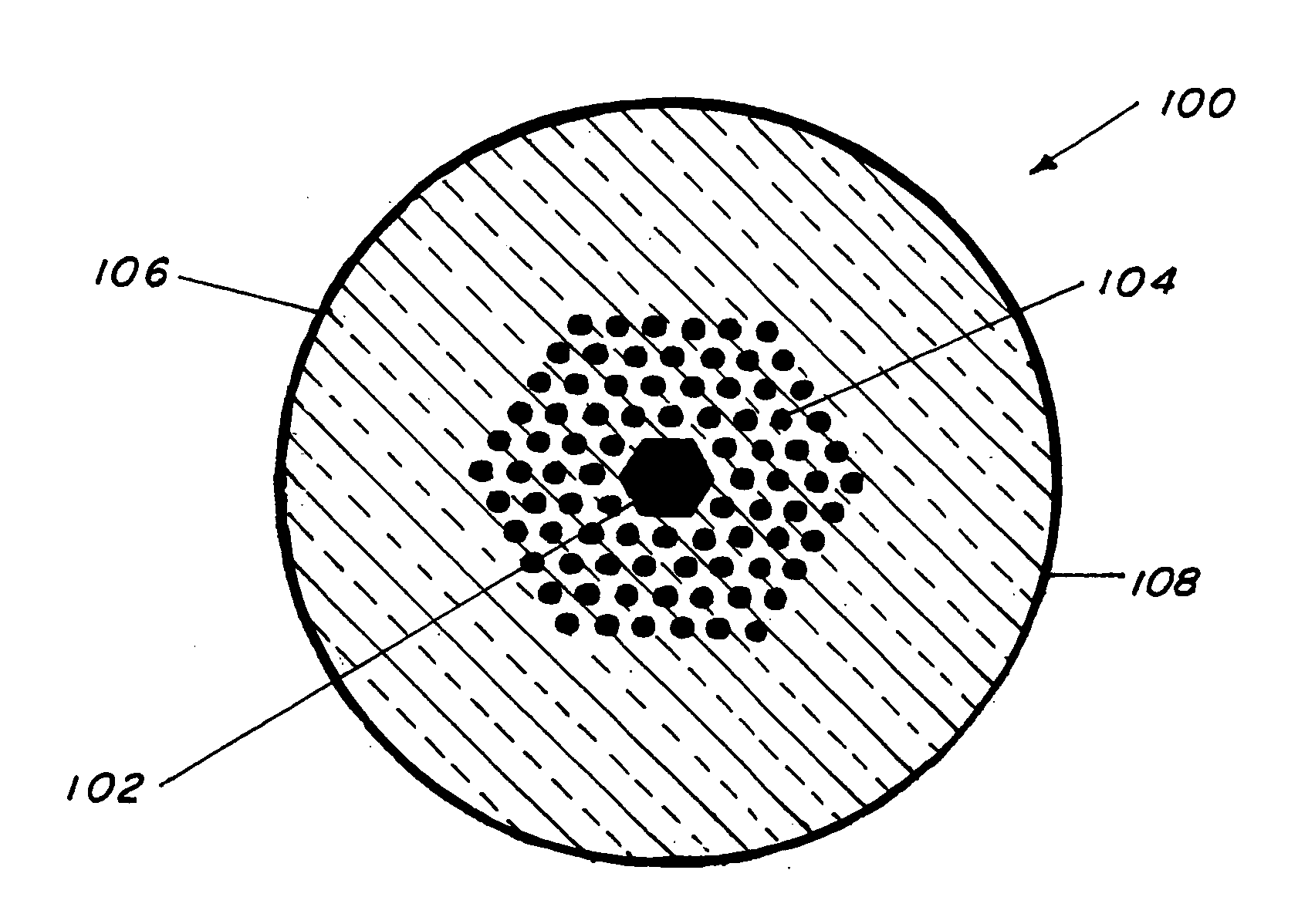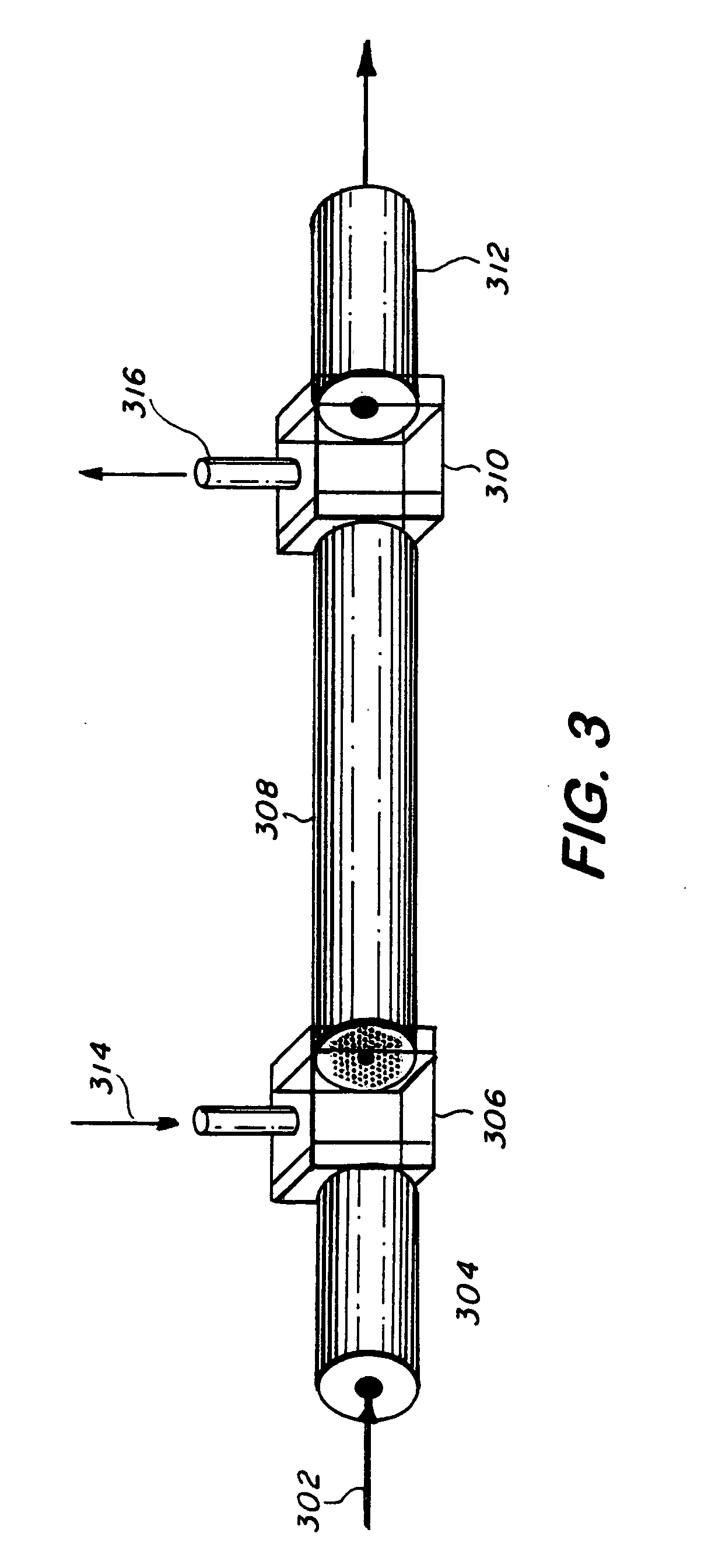Hollow core photonic band gap infrared fibers
a technology of infrared fibers and hollow cores, which is applied in the field of hollow core photonic band gap chalcogenide fibers, can solve the problems of limited sensitivity of inability to use hollow core pbg silica fibers for fingerprint spectroscopy, and inability to transmit well. , to achieve the effect of increasing the sensitivity of sensing molecular species
- Summary
- Abstract
- Description
- Claims
- Application Information
AI Technical Summary
Benefits of technology
Problems solved by technology
Method used
Image
Examples
example 1
[0032] This example describes the method to fabricate a hollow core photonic band gap fiber from selenide-based chalcogenide glass with composition of As39 Se61.
[0033] The fabrication method included batching arsenic and selenium in pre-cleaned quartz ampoules using a glass box containing nitrogen with less than 100 ppb moisture and less than 1 ppm oxygen. The ampoules were evacuated to about 10−5 Torr and sealed using an oxygen-methane torch. The ampoules were then placed in a furnace and heated to about 800° C. and the batch allowed to react for about 10 hours and then further distilled to further purify the chemicals. Purification here is based on experience and purity of glass sought is up to about 0.5 dB / m and higher. The distillate was remelted for homogenization and then spun at about 2500 rpm while still molten in the ampoule. During cooling of the melt, while still rotating in the ampoule, the viscosity increased and a tube was formed, annealed and removed from the ampoule...
example 2
[0035] This example details the method to fabricate the hollow core photonic band gap fiber from sulfide-based chalcogenide glass with composition of As39 S6, but without the outer solid region that provides structural integrity to the fiber, particularly to the microstructured region.
[0036] The fiber was made by fabricating tubes, stretching by drawing them to micro-tubes, stacking, fusing and redrawing into fiber of the micro-structured sulfide preform, in a similar manner to Ex. 1 with the exception that there were no outer rods, i.e., micro-canes, used for mechanical integrity. Also, no Teflon®-coated mold was used but instead, the sulfide micro-tubes were stacked around a similar central sulfide micro-tube to form the preform and this was drawn into 95 μm outside diameter fiber. Again, high purity glass and high precision diameter tubes were not used nor was the gas pressure inside the tubes controlled during fiber drawing. Improvements in controlling these parameters will lea...
example 3
[0037] This example describes the use of a selenide fiber of this invention for chemical identification using remote infrared spectroscopy, using the system generally depicted in FIG. 3 but without coupling fibers 304 and 312.
[0038] The sensing step includes the steps of directing infrared light into hollow core of the glass fiber of this invention, introducing analyte into the core of the fiber, transmitting the light and the analyte into the core of the fiber, and analyzing the light emanating from the fiber for presence of the analyte. Pursuant to the sensing method, hollow core photonic band gap fiber of Ex. 1 was coupled at one end to a source from an Analect Diamond 20 FTIR spectrometer. The distal end of the fiber was coupled to a liquid nitrogen HgCdTe detector. A small quantity of acetone was drawn into the hollow core through capillary action. The periodic holes were blocked-off with wax prior to this step. The infrared spectrum of acetone was recorded and the relative tr...
PUM
| Property | Measurement | Unit |
|---|---|---|
| outer diameter | aaaaa | aaaaa |
| thick | aaaaa | aaaaa |
| thick | aaaaa | aaaaa |
Abstract
Description
Claims
Application Information
 Login to View More
Login to View More - R&D
- Intellectual Property
- Life Sciences
- Materials
- Tech Scout
- Unparalleled Data Quality
- Higher Quality Content
- 60% Fewer Hallucinations
Browse by: Latest US Patents, China's latest patents, Technical Efficacy Thesaurus, Application Domain, Technology Topic, Popular Technical Reports.
© 2025 PatSnap. All rights reserved.Legal|Privacy policy|Modern Slavery Act Transparency Statement|Sitemap|About US| Contact US: help@patsnap.com



